|
By
Vidushi Seneviratne
With
this being the 2550th Buddha Jayanthi year, signifying 2550 years
since the passing away of Lord Buddha, many special religious programmes
are being organised around the island to celebrate Vesak poya. The
historic Ridhi Viharaya in the Kurunegala district will also be
the focus with several programmes being conducted there.
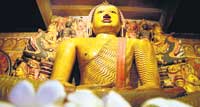 Situated in Ridhigama, a village about 10 kilometres from Mallawapitiya,
a town on the Kurunegala-Kandy road, the Rajamaha Viharaya dates
back over 2000 years. Built by King Dutugemunu, the temple spreads
over about 30 acres, making it one of the most picturesque religious
sites in the area.
Situated in Ridhigama, a village about 10 kilometres from Mallawapitiya,
a town on the Kurunegala-Kandy road, the Rajamaha Viharaya dates
back over 2000 years. Built by King Dutugemunu, the temple spreads
over about 30 acres, making it one of the most picturesque religious
sites in the area.
So how did it originally get its name? “During King Dutugemunu’s
era, while he was building the sacred Ruvanweliseya, people were
discovering precious metals in different areas of the island and
silver or ridhi was found in this particular area. This is how both
the temple and the village got its name,” says Ven. Buddha
Rakkhitha, the chief guardian priest of Ridhi Viharaya. The temple
falls under the purview of the Mahanayake of the Malwathu Chapter.
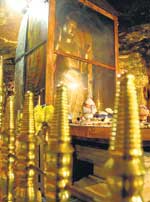 Having numerous special features, the temple is most famous for
its paintings belonging to the Kandyan era, a unique Makara Thorana
and ivory carvings. “The Makara Thorana at this temple is
different to others. Normally the heads of the two Makarayas turn
towards the Buddha statue. But in this particular one, the heads
are turning outward and away from the statue. Also, normally there
are only about four gods depicted on either side of the statue,
but this Makara Thorana has many gods depicted,” said the
Ven. Thera. Going on to describe the ivory carvings, he said this
is probably the only instance where such carvings have been inserted
into a part of the roof of a temple.
Having numerous special features, the temple is most famous for
its paintings belonging to the Kandyan era, a unique Makara Thorana
and ivory carvings. “The Makara Thorana at this temple is
different to others. Normally the heads of the two Makarayas turn
towards the Buddha statue. But in this particular one, the heads
are turning outward and away from the statue. Also, normally there
are only about four gods depicted on either side of the statue,
but this Makara Thorana has many gods depicted,” said the
Ven. Thera. Going on to describe the ivory carvings, he said this
is probably the only instance where such carvings have been inserted
into a part of the roof of a temple.
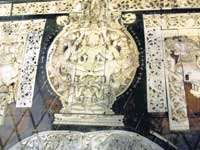 Yet another interesting artefact at Ridhi Viharaya is a line of
tiles portraying the life of Christ. Fixed along the stand built
for offering flowers to Lord Buddha, the presence of these tiles
in the temple is remarkably interesting. Possibly being presented
to the temple by a Dutch governor, the temple officials may have
incorporated it in the viharaya.
Yet another interesting artefact at Ridhi Viharaya is a line of
tiles portraying the life of Christ. Fixed along the stand built
for offering flowers to Lord Buddha, the presence of these tiles
in the temple is remarkably interesting. Possibly being presented
to the temple by a Dutch governor, the temple officials may have
incorporated it in the viharaya.
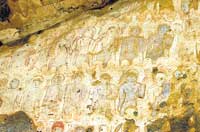 Consisting of many rock caves, the viharaya has been built in the
cave where the silver was originally found. Called Maha Viharaya,
it has a large reclining Buddha statue and statues of God Vishnu
and King Dutugemunu, along with paintings belonging to the Kandyan
era and a few other rare statues made of ceramic.
Consisting of many rock caves, the viharaya has been built in the
cave where the silver was originally found. Called Maha Viharaya,
it has a large reclining Buddha statue and statues of God Vishnu
and King Dutugemunu, along with paintings belonging to the Kandyan
era and a few other rare statues made of ceramic.
“The Ridhi Viharaya was reconstructed during the Anuradhapura
era by King Amandha Gamini and once again by King Keerthi Sri Rajasinghe
during the Kandyan era. During these reconstructions, little changes
have been added to the temple over the years,” said the Thera.
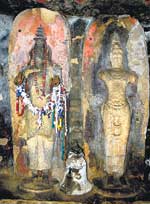 Among the other artefacts in the temple, is also a unique carriage
that was used to transport monks of the ancient times, as well as
two seats used by monks to preach bana.
Among the other artefacts in the temple, is also a unique carriage
that was used to transport monks of the ancient times, as well as
two seats used by monks to preach bana.
The programme planned for Vesak Poya at Ridhi Viharaya begins on
May 12 and goes on till May 16. Consisting of an Aloka pooja, a
lantern competition and Bhakthi Geetha, the programme will involve
residents of Ridhigama.
“Children and young people of the area will sing Bhakthi Geetha
and make lanterns to commemorate Vesak,” said the Thera.
Apart from these, there will also be a number of pandals around
the town as well.
|
 Situated in Ridhigama, a village about 10 kilometres from Mallawapitiya,
a town on the Kurunegala-Kandy road, the Rajamaha Viharaya dates
back over 2000 years. Built by King Dutugemunu, the temple spreads
over about 30 acres, making it one of the most picturesque religious
sites in the area.
Situated in Ridhigama, a village about 10 kilometres from Mallawapitiya,
a town on the Kurunegala-Kandy road, the Rajamaha Viharaya dates
back over 2000 years. Built by King Dutugemunu, the temple spreads
over about 30 acres, making it one of the most picturesque religious
sites in the area.  Having numerous special features, the temple is most famous for
its paintings belonging to the Kandyan era, a unique Makara Thorana
and ivory carvings. “The Makara Thorana at this temple is
different to others. Normally the heads of the two Makarayas turn
towards the Buddha statue. But in this particular one, the heads
are turning outward and away from the statue. Also, normally there
are only about four gods depicted on either side of the statue,
but this Makara Thorana has many gods depicted,” said the
Ven. Thera. Going on to describe the ivory carvings, he said this
is probably the only instance where such carvings have been inserted
into a part of the roof of a temple.
Having numerous special features, the temple is most famous for
its paintings belonging to the Kandyan era, a unique Makara Thorana
and ivory carvings. “The Makara Thorana at this temple is
different to others. Normally the heads of the two Makarayas turn
towards the Buddha statue. But in this particular one, the heads
are turning outward and away from the statue. Also, normally there
are only about four gods depicted on either side of the statue,
but this Makara Thorana has many gods depicted,” said the
Ven. Thera. Going on to describe the ivory carvings, he said this
is probably the only instance where such carvings have been inserted
into a part of the roof of a temple.  Yet another interesting artefact at Ridhi Viharaya is a line of
tiles portraying the life of Christ. Fixed along the stand built
for offering flowers to Lord Buddha, the presence of these tiles
in the temple is remarkably interesting. Possibly being presented
to the temple by a Dutch governor, the temple officials may have
incorporated it in the viharaya.
Yet another interesting artefact at Ridhi Viharaya is a line of
tiles portraying the life of Christ. Fixed along the stand built
for offering flowers to Lord Buddha, the presence of these tiles
in the temple is remarkably interesting. Possibly being presented
to the temple by a Dutch governor, the temple officials may have
incorporated it in the viharaya.  Consisting of many rock caves, the viharaya has been built in the
cave where the silver was originally found. Called Maha Viharaya,
it has a large reclining Buddha statue and statues of God Vishnu
and King Dutugemunu, along with paintings belonging to the Kandyan
era and a few other rare statues made of ceramic.
Consisting of many rock caves, the viharaya has been built in the
cave where the silver was originally found. Called Maha Viharaya,
it has a large reclining Buddha statue and statues of God Vishnu
and King Dutugemunu, along with paintings belonging to the Kandyan
era and a few other rare statues made of ceramic.  Among the other artefacts in the temple, is also a unique carriage
that was used to transport monks of the ancient times, as well as
two seats used by monks to preach bana.
Among the other artefacts in the temple, is also a unique carriage
that was used to transport monks of the ancient times, as well as
two seats used by monks to preach bana.